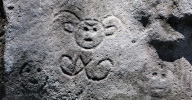| Kaz | Enfo | Ayiti | Litérati | KAPES | Kont | Fowòm | Lyannaj | Pwèm | Plan |
| Accueil | Actualité | Haïti | Bibliographie | CAPES | Contes | Forum | Liens | Poèmes | Sommaire |
Ayiti Jean-Michel Basquiat Du 20 mars au 19 juin 2004, 
Basquiat 1982 Polaroid par Andy Warhol. |
After the retrospectives devoted to Georges Rouault (1997), Edvard Munch (1998), Amedeo Modigliani (1999), Ernst Ludwig Kirchner (2000), Marc Chagall (2001) and Egon Schiele (2003), the Museum of Modern Art of the City of Lugano will now be housing an exhibition devoted to Jean-Michel Basquiat (1960-1988), one of the main protagonists of the international artistic scene of the eighties.
This retrospective, which promises to be the most complete tribute – the first in Switzerland and one of the biggest in Europe – to the work of Basquiat, spans the entire artistic career of this legendary figure, defined in his day as the "Jimi Hendrix of art", or even the "Child King", in an attempt to offer the public a new opportunity to come to grips with the contemporary languages of XX century art.
Basquiat, a martyr to his own inner fire that burnt out his very existence at the age of only 27, began in the artistic world with the famous graffiti signed SAMO - his identification mark - and was recognised, together with Keith Haring, as belonging to the American graffiti movement of the late seventies.
After, at the beginning of the eighties, having participated in collective exhibitions held in off-beat locations to offer an overall impression of the New York artistic cultural scene of the day, Basquiat – at only 21 years old – was officially launched in the art world as a painter thanks to an article written by the critic, René Ricard, who placed him alongside masters such as Cy Twombly and Jean Dubuffet.
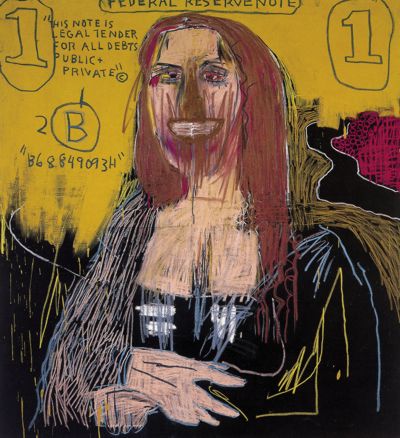 |
Mona Lisa -
1983 © The Estate of Jean-Michel Basquiat Collection Ambrous T. Young This work seems to be Basquiat's answer to Warhol's Dollar Bill and Mona Lisa paintings. Basquiat usually paints large fields of colour by applying broad brush strokes with acrylic paint, while drawing and writing in oil stick. This pattern applies to the orange top part of this painting. The portrait at centre, however, has hair, skin and parts of the bust filled-in with repeated oil stick lines. Leonardo's Mona Lisa seems to grow into the dollar note at top, obscuring what would be the face of George Washington. Art and money are two different currencies, even different worlds, which can be converted only with difficulty. The uncompromising and urgent way the artist spent the money he made is legend. In this painting he lets us know that although he loved money his ultimate faith lay in art. |
Basquiat was one of the few emerging artists not only to enjoy immediate international fame but also to be suddenly called upon to expose his own works in the most notable galleries of New York and, subsequently, the rest of the world.
Basquiat was intelligent, curious and full of joie de vivre and he broke with tradition and imposed his truth, denouncing the dangers of modern life – money, drugs, sex, flattery, oppression and racism. The rebellious artist incorporated every sort of element into his works, from the symbols of mass culture, to references to the mythology of jazz, from the representation of coloured heroes who had become famous in sport and music, to the skeletons and skulls inspired by his attraction to death.
His creations are a blend of symbols, writing and colours. The colours are not those of a picture on a medium achieved by studied art; they are the colours of the street, of the city, at the same time vivid and faded, laid one upon the other like strips of torn advertising posters.
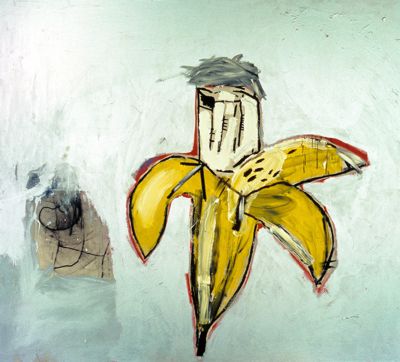 |
Brown Spots (Portrait of Andy Warhol as a Banana) - 1984 © The Estate of Jean-Michel Basquiat Private collection, New York Andy Warhol is shown as a banana in this portrait. It is only the unlikely silver wig that Warhol always wore in the eighties that identifies the image as being of him. Indeed the silver wig on any object would identify it as Warhol. 1984 was the first year in which Basquiat spent significant amounts of time with the older artist, having been finally formally introduced by Bruno Bischofberger at the end of 1982. In this picture Basquiat paints his friend in jest but also with great affection. There are a number of portraits the artists did of each other, but this one occupied a special place in Basquiat's heart. It was hung on a wall by itself in the Mary Boone - Micheal Werner Gallery exhibition of 1984, while the other paintings were jammed together on other walls, even though Boone had advised the artist to hang the show more sparsely. |
The exhibition is laid out in a chronological sequence, by a rigorous choice of works from major museums and private collections, and it comprises some fifty or so paintings, a score of drawings and some "collaborations" created together with Andy Warhol and Francesco Clemente, canvasses commissioned by the Zurich art dealer, Bruno Bischofberger. It was precisely with Warhol that the artist was to establish one of the closest ties of his life and the passing of the master of Pop Art in 1987 was to leave a void in Basquiat's life that was never to be filled.
As a finishing touch to the visit to the exhibition, the hitherto unpublished photos by the Lugano director, Edo Bertoglio, some of which were taken during the shooting of the film "New York Beat" renamed "Downtown 81", in which Basquiat played himself in the main role of an as yet unknown 19-year-old artist who tries to survive in the lively artistic and musical community of down-town New York in the early eighties.
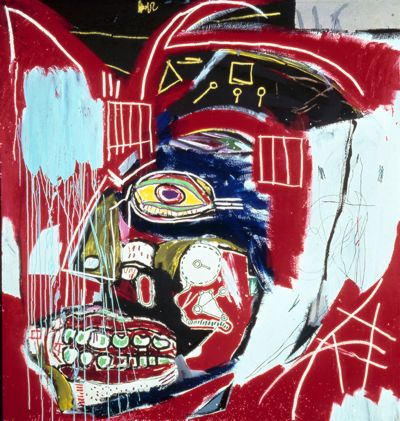 |
In this Case -
1983 © The Estate of Jean-Michel Basquiat Private collection Raw and gentle, savage and caring, rough and sophisticated, naive and precocious, simple and intricate, material and spiritual. These juxtapositions and seeming negations all seem to co-exist in the artist, the body of work he has left behind and in this masterpiece. A vibrant red is the dominant colour that frames most of the other elements. A single multicoloured eye looks out at the viewer with a white dial underneath through which we can see the unpainted canvas, a stripe of which is also visible on the right and which might indicate hair. It is rare for the composition to be so unitary, consisting of only one head, so large relative to the canvas, and yet consist of so many beautifully worked details. The image can be read as both a head and a skull. |
Biographie
Jean-Michel Basquiat est né en 1960 à Brooklyn, il est à moitié Haïtien, à moitié Portoricain. Les années de squat et de débrouille, en compagnie de Diaz, le complice des tags signés Samo, – Sa me O ld S hit – sont décisives pour son art.
A moins de 20 ans, Jean-Michel Basquiat est le premier à amener l'art de la rue dans les musées, en 1983, il est le plus jeune artiste à entrer au Whitney Museum. Basquiat meurt, probablement d'une overdose, en août 1988.
Les rapports de Jean-Michel Basquiat avec la Suisse sont multiples: son principal galeriste est le Zürichois Bruno Bischofberger. Il expose très vite à Zürich, de nombreux collectionneurs suisses l'achètent. Il vient parfois en vacances, notamment en compagnie d'Andy Warhol, dans le chalet des Bischofberger. Jean-Michel Basquiat a peint 800 à 900 tableaux et réalisé environ 1'500 dessins.
Le Musée d'Art Moderne de Lugano propose une riche rétrospective de son œuvre. De nombreuses peintures, des dessins et aussi quelques tableaux issus de la fameuse exposition zürichoise sont le fruit de la collaboration entre Basquiat, Warhol et Francesco Clemente.
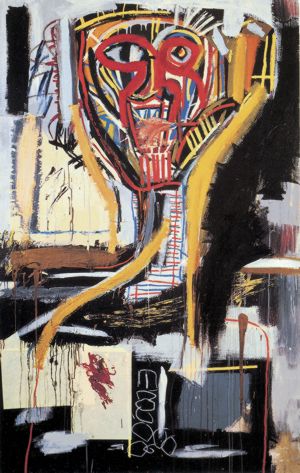 |
Untitled (Prophet I) -
1982 The primordial mass at the bottom and sides of the painting are sucked into an upper body that becomes increasingly more defined, culminating in a quite intricate and multicoloured head, as if a figure was turning to look back over its left shoulder. The progression of chaos to order that is visible is a metaphor for the synthetic construct created by the human brain on a continual basis that we refer to as consciousness. The whole composition is reminiscent of an earlier generation of Abstract Expressionist artists. Franz Kline, in the broad black brushstrokes, Willem de Kooning in the frenzied splatter of paint over the mouth, and Robert Rauschenberg, who Basquiat very much admired, in the overall composition. The way in which the figure stares out of the canvas makes the viewer involuntarily aware of himself. |
Basquiat: Rage To Riches By BBC Publiée par Contemporary Haitian Art sur Samedi 17 mars 2018 |
Exposition photographique : Basquiat by Edo Bertoglio
Ho conosciuto Jean-Michel Basquiat nel 1979 a New York, allorché era ancora un aspirante artista squattrinato che conquistava le donne con il suo charme per trovare un tetto sotto il quale passare la notte. Quando mi svegliavo la mattina, uscivo dal mio loft a Bleeker Street e ammiravo in strada i suoi “capolavori”, i graffiti che dipingeva di nascosto sui muri della città, rigorosamente firmati SAMO (Same Old shit). Tutto l'East Village lo adorava. Nessuno avrebbe immaginato che quel ragazzo mite sarebbe diventato il Basquiat osannato dalla critica e oggi ammirato nei grandi musei di tutto il mondo. La nostra fu una grande amicizia e sfociò in un progetto artistico comune: il mio primo film, Downtown 81, in cui Jean-Michel interpreta se stesso. Si tratta di una giornata nella sua vita di artista di belle speranze e senza un soldo, costretto a vendere in fretta un suo quadro (il primo che effettivamente Jean-Michel dipinse su tela per esigenze di copione) al fine di sopravvivere.
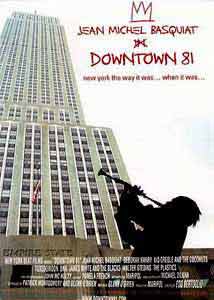
In quel tempo lo stanzino affittato per la produzione diventava di notte la sua casa. Ogni giorno trovavamo opere dipinte sul frigorifero, sulle pareti o dovunque esistesse una superficie liscia; la sua ispirazione non poteva attendere. Mi dedicò alcuni disegni, raffiguranti soprattutto delle macchine fotografiche, dei quali sono molto orgoglioso, e un autoritratto, che purtroppo ora ho la possibilità di vedere solo nei musei e sui cataloghi.
Durante le riprese del film gli scattavo foto in continuazione, sul set e nei momenti di relax. Sono le immagini dedicate a un amico con il quale ho condiviso un periodo intenso e che poi ha catalizzato l'attenzione di tutti in un breve intervallo di grande fertilità artistica, tra il 1981 e il 1987, lasciando in seguito spazio alla sua arte a colmare il vuoto della sua scomparsa.
J'ai connu Jean-Michel Basquiat en 1979, alors qu'il n'était encore qu'un jeune artiste un peu fauché, qui conquérait les femmes par son charme, juste pour trouver un toit sous lequel passer la nuit. Quand je me réveillai le matin, je sortai de mon loft à Bleeker Street et j'admirai sur la rue ses «Chefs d'œuvre», les graffiti qu'il peignait en cachette sur les murs de la ville, systématiquement signés SAMO (Same Old Shit). Tout l'East Village l'adorait. Personne n'aurait imaginé que ce garçon miteux allait devenir le Basquiat encensé par la critique et aujourd'hui admiré dans les plus grands musées du monde. Notre amitié fut très profonde et donna lieu à un projet artistique commun: mon premier film, Downtown 81 , dans lequel Michel s'interprète lui-même. Il s'agit d'une journée de sa vie d'artiste, de belles espérances et pas un sou, contraint de vendre vite ses tableaux (le premier que Jean-Michel peignit sur toile pour les exigences du film) pour survivre.
Pendant cette période, la petite chambre louée pour la production devenait sa maison durant la nuit. Chaque jour nous trouvions des œuvres peintes sur le frigo, sur les murs ou partout où il y avait une surface libre; son inspiration ne pouvait pas attendre. Il me dédia quelques dessins, représentant surtout des appareils photographiques, dont je suis aujourd'hui très fier et un autoportrait, que je n'ai malheureusement plus la possibilité d'admirer, excepté dans les musées ou sur des catalogues.
Pendant le tournage du film, je le prenais constamment en photo, sur le set et pendant les moments de tranquillité. Ce sont toutes des images dédiées à un ami avec lequel j'ai partagé une intense période et qui plus tard, a focalisé l'attention de tous pendant une trop brève période de grande fertilité artistique, entre 1981 et 1987, laissant finalement à son art le soin de combler le vide de sa disparition. - Edo Bertoglio.
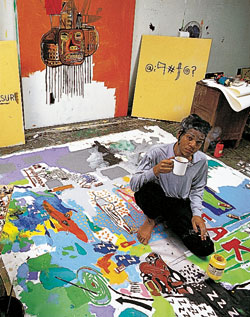
The catalogue
The exhibition mounted at the Museo d'Arte Moderna of the City of Lugano is accompanied by an extensive catalogue of 200 pages, published by Skira in two distinguished versions, in Italian and in English. It will be on sale, during the period of the exhibition, at the price of Fr. 50.- / EUR 35.-
The volume, which includes colour photographs of each piece within the exhibition, illustrates the entire artistic path of a great figure of the modern figurative panorama.
These are the essay and the authors:
- Achille Bonito Oliva
The Perennial Shadow of Art in Basquiat's Brief Life - Henry Geldzahler
Art: From Subways to SoHo, Jean-Michel Basquiat - Richard D. Marshall
Jean-Michel Basquiat: Speaking in Tongues - Jeffrey Hoffeld
Word Hunger: Basquiat and Leonardo - Bruno Bischofberger
Jean-Michel Basquiat, Francesco Clemente and Andy Warhol: Collaborations - Luciano Caprile
Jean-Michel Basquiat. The Word and the Image
For each painting there is a written comment by Luca Marenzi: detailed and comprehensive technical entries that consent an in-depth analysis of Basquiat's motivations, style and expressive language. The catalogue is completed by a rich section of apparatus, inclusive of biography and a selected bibliography.
 |
Tenor -
1985 The canvas is completely covered with colour Xeroxes. The following four Xerox images appear twice. The block of text at top left above the bird's head is repeated at bottom left under the right wing of the lowest bird; the brown box left of the second text can be found again above right of the bird's head we started at; the hollow yellow shape directly above the same bird's head re-appears under the middle bird down on the left side. Finally the image in the top right corner is repeated under the right fist of the figure at bottom right. The figure's mouth is open and might therefore be the tenor singer of the title, although tenor saxophone more naturally springs to mind. Tenor might alternatively refer to the general tone of the painting that is set by the black animal figures. The word RATON that is repeated three times at centre is Spanish for "mouse". |
- Site
- Downtown 81 film de Edo Bertoglio.
- Museo d'Arte Moderna, Lugano, Suisse.
- Info Exposition: Sabina Bardelle - Tel: +41 (0)58 866 7201 - Fax: +41 (0)58 866 7497 - E-mail
- Exposition retrospective, Fondation Beyler - Bâle (Suisse), du 9. mai au 5. septembre 2010.
- Jean-Michel Basquiat. Engadin, exposition à St. Moritz (Suisse) en 2025.
*
